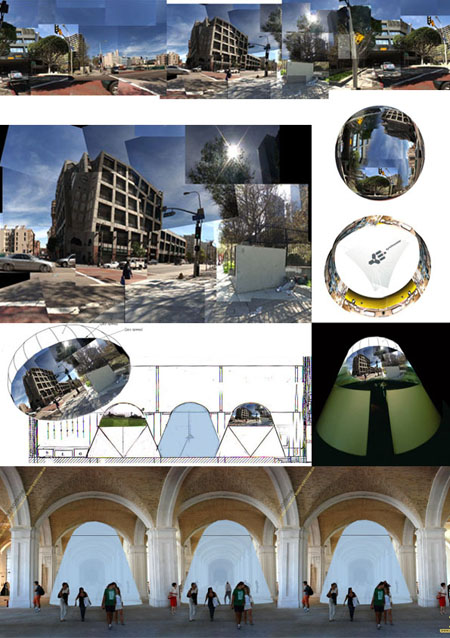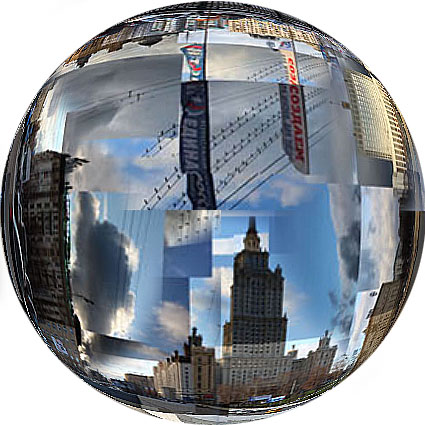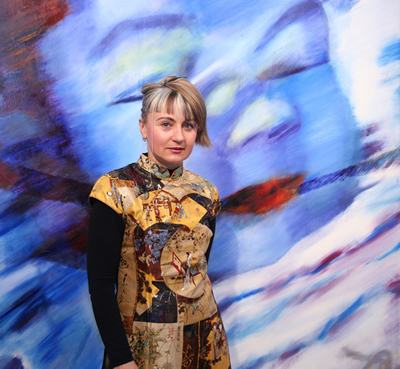ARCHITECTURE+PHILOSOPHY 2012
Collider: Volatile correspondences
OKSANA CHEPELYK
A correspondence between
Oksana Chepelyk and Esther Anatolitis
> JUMP TO DISCUSSION
OKSANA CHEPELYK My current work under development is the Collider project that works with time, space, science, urbanism, history and new technologies. Collider examines the iconic places of USA, Russia and Ukraine of C20-21 political history, presented in panoramic projections under 3 silver domes. The project deals with events which took place in different urban landscapes, which had an influence on subsequent historical development. This large, long-term project began in the USA, in Dallas – on the site of the John F. Kennedy assassination – and brings Ukraine into this politically sited world context via to the Chernobyl catastrophe, the Orange revolution etc.
A collider accelerates two beams of particles that are directed against each other under experimentally controlled conditions, so that the particles collide while flying in opposite directions. This process can be used to make strange and anti-matter. If the latest theory of Tom Weiler and Chui Man Ho is right, the Large Hadron Collider – the world’s largest atom smasher that started regular operation last year (which, the mass media would have us believe, can cause the danger of Apocalypse) – could be the first machine capable of causing matter to travel backwards in time. And time, of course, is one of the fundamental concepts for physics and philosophy, one of the key co-ordinates of space-time. In the project, time is presented by projected video that consists of 24 fragments of moving image, which will be revolved with acceleration in an artistic collider, activated via a mechanism of audio-visual jumps where certain fragments will gradually be substituted by archival videos.

ABOVE Oksana Chepelyk: Moscow-Kiev
For the realisation of the project, I’m looking for specific fragments of archival materials, and I have captured video from a consistent perspective in Chernobyl, at Independence Square in Kiev and at the Potiomkin Stairs in Odesa (both sites are revolutionary and cultural phenomena), at the site of the World Trade Centre memorial in New York, and next to the White House in Moscow. I am considering the possibility of developing Collider further – examining the Geumnamno street in Kwangju (South Korea), the Tiananmen Square in Beijing (China), the former Berlin Wall (Germany), Freedom Square in Tbilisi (Georgia), Paradis (Fardus) Square (now Freedom Square) in Baghdad (Iraq), Mexico City’s Zócalo and Paseo de la Reforma (Mexico), and Tahrir Square in Cairo (Egypt).
It is a critical art that testifies today’s social reality and its traumas. It is important as an approach in art to certify and record some corporeal feeling of contemporaneity, for sake of the future.
The Collider project, working with the events that have formed the world in which we live now, raises the question: is a person a particle in the system of accelerators of global forces, or the energy of interaction investigating new values, new forms of thought and new ways of existence in the world – insisting that another world is possible?
ESTHER ANATOLITIS The Best of Times, the Worst of Times – Rebirth and Apocalypse in Contemporary Art. This is the theme of Arsenale 12’s Inaugural Kiev Biennale of Contemporary Art, the context in which Oksana is developing her current works. In the theme’s articulation, collisions between past, present and future offer their own sets of correspondences. A Tale of Two Cities’ revolutionary setting is juxtaposed with disappointingly poor human rights advances since; ever more strident humanist discourses, ever more violent wars. Are ‘best’ and ‘worst’ opposites, or productive tensions? “Within the ‘worst’ redemption lies dormant, while the ‘best’ may be an illusion that harbours the seeds of its own destruction.” Hurtling towards a supercollision of world-historic accumulation, or taking it one collision at a time, the Kiev Biennale (24 May to 31 July, 2012) sets important tensions into play for reactions to Oksana’s work.
Under experimental conditions, colliders set quantum particles on collision courses with one another to generate strange matter, anti-matter. Under planetary conditions we set human particles on collision courses that generate accidental matter, violent matter, discursive matter, political matter, ethical matter, matter of great weight and matter of no consequence. Oksana’s investigations look into pivotal, sited historical moments. Yet even as we recoil from their momentous consequences, are we focusing on the right conflict? The right scale? The right dimension? Volatile correspondences demand something of us as interpreters of our times. Our responses are always multi-dimensional – they are emotional, practical, political – and we continue to pore through the accounts with the rationality of hindsight, lest we become overwhelmed. Even now, Collider enfolds us in corporeal reality to manifold collisions of past and future.

ABOVE Calabi-Yau manifold
Our CORRESPONDENCE:8 has taken the form of a cadavre exquis, a wicked recipe for a volatile collision. Oksana has offered me the tantalising provocation of a 6-dimensional Calabi-Yau manifold to spark our correspondence – itself a complex, self-enfolded theoretical object. A manifold is a mathematical object that appears flat and predictable at the small scale, but in fact curves and extends in unexpected ways, possibly even across multiple dimensions. Mathematically, manifolds appear locally Euclidean, but are in fact globally non-Euclidean when the mathematical function that defines them is charted. Sometimes these dimensions are differentiable: differential calculus allows us to make a flat map of the Earth, for example, taking the three-dimensional globe down to two in order to depict the continents in shapes we recognise, yet losing global accuracy in favour of local detail. Another familiar example: the Möbius strip is a two-dimensional compact manifold, a continuously flat surface which in fact loops onto itself – and indeed, it is this curvature that gives rise to its continuous flatness.
The Calabi-Yau manifold is a complex manifold which represents the extra dimensions of space-time that are projected by theoretical mathematics and physics – particularly string theorists. According to superstring theory, at every point in our four-dimensional space, a 6-dimensional Calabi-Yau manifold is attached – so small that they’re at the Planck scale, the subatomic scale at which quantum field theory breaks down and gravitational forces becomes erratic. These problematic scales are one of the objects of Oksana’s investigations. The smallest particles, accelerated and brought into contact with one another, disfigure the experience of space-time – and thus, subjectively, space-time itself. Multi-dimensional manifolds incorporate these fluctuations – both quantum and geometric – giving rise to complex folds, complex forms. Unexpected mergence and uncontainable risk, rebirth and apocalypse are both contained in those moments. What the Calabi-Yau manifold introduces is the possibility of an additional six dimensions beyond our familiar length, breadth, height and duration: six dimensions to chart and understand in minute detail; six dimensions which themselves will appear locally flat and navigable, yet globally intricate and unchartable; six dimensions (why six?) which will complexify those collisions at least sixfold.

ABOVE Oksana Chepelyk: Moscow Dome
OKSANA CHEPELYK Visually it is a very enfolding idea, the manifold, but my interest extends to the fragmentation and discontinuity. In my project, a fragmented representation of a time and space makes reference to the quantum theory, or if you like, the hypercube notion (see for example, the rotating tesseract). In my work, a paradoxically fragmented urban scape will be organised in a spherical 360° full dome projection, but at the same time, it is about a time and space that has existed historically.
There is a growing conviction that the world as we know it should end. In fact, the resounding crash of global financial capitalism and spectacular manifestations of discontent all over the world are telling us that the world of unrestrained consumption is already on its deathbed. Why wait passively until the system decomposes by itself – until “the world ends”? Why not start inventing a new world – the one that will succeed the current apocalypse?
We welcome your correspondence...
ABOUT THE CORRESPONDENTS

OKSANA CHEPELYK (Kiev, Ukraine) is an artist, filmmaker and curator, with formal qualifications in art and architecture. Oksana studied at the State Institute of Art in Kiev, with postgraduate studies in Moscow, the CIES in Paris and Amsterdam University. As an artist she was awarded grants in France, Germany, Spain, USA, Canada and England (1992-2003). Her works have been exhibited widely: 1998 MOMA, New York, 1999 “ART FAIR” Stockholm, Sweden, 1999 Museum of Contemporary Art, Zagreb, Croatia, 2000 German Historical Museum, Berlin, 2001 Munich, Germany, 2000 ISEA, Paris, 2001 Museum of the Arts History, Vienna, Austria, 2002 “SEAFair”, Museum of Contemporary Art, Skopje, Macedonia, 2003, 2007, 20011 Museum of Jurassic Technologies, Los Angeles, USA, 2008 “DIGITAL MEDIA Valencia”, Spain, VII Digital Art Salón, MACZUL Museum of Contemporary Art del Zulia, Maracaibo, Venezuela, 2009, 2010 “ArtVilnius”, Vilnius, Lithuania, 2010 “Sarajevo Winter” Art Biennale, Sarajevo, Bosnia and Herzegovina, 2011 Broad Art Center, Los Angeles, USA, Art Arsenal Museum, Kiev, 4th Biennale of Contemporary Art, Moscow, Russia, 6th Tashkent Biennale of Contemporary Art, Uzbekistan (Award). In 2002 at the Bauhaus, she collaborated with Esther Anatolitis on the short film Urban Multimedia Utopia, which was presented at festivals in Germany, France, Italy and Israel, and won the Special Werkelitz Award at the 2003 European Media Arts Festival. In 2003-2004, 2010-2011 she was a Fulbright researcher at UCLA. Since 2007 Oksana is Artistic Director of the International Festival of Social Sculpture in Kiev.
Current and recent work by Oksana Chepelyk:
Collider Work in progress: LA Riot / Dallas
Collider Work in progress: Moscow
5 videos 5 fragments 5 minutes
DEAF MUTE CHORUS 5 min.
URBAN MULTIMEDIA UTOPIA 10 min.
VIRTUAL SEA TOWER 5 min.
GENESIS 3 min.
SHIFTING TIME 6 min.
VIRTUAL NOOSPHERE 13 min.
FAREWELL TO SKYSCRAPERS! – I 4 min.
FAREWELL TO SKYSCRAPERS! – II 3 min.
MANIFESTO 5 min.
Upcoming exhibitions by Oksana Chepelyk:
- Concerning Scenography – Unrealised Projects in Modern Art Research Institute of NAAU (opening: March 23)
- Contemporary Art and Ukrainian Baroque in National Art Museum (opening: April 27)
- Arsenale 2012 – The 1st Kiev International Biennial of Contemporary Art with the theme: The Best of Times, The Worst of Times. Rebirth and Apocalypse in Contemporary Art (opening: May 23)
- Public art project: May 25.
ESTHER ANATOLITIS is Co-curator of Architecture+Philosophy.
Architecture+Philosophy is
an independent, flexible public program, co-curated by Esther Anatolitis and Dr
Hélène Frichot since 2005.
Join
our mailing list to remain updated. It's a small text-only email
which you'll receive two or three times a month. You can find us on Facebook and you can also follow Hélène and Esther on Twitter.
PAST
YEARS' PROGRAMS 2011 / 2010 / 2009 / 2008 / 2007 / 2006 / 2005
JOIN
THE MAILING LIST / ABOUT THE CURATORS |
CORRESPONDENCES: 8
PAST
YEARS' PROGRAMS 2011/ 2010 / 2009 / 2008 / 2007 / 2006 / 2005 / MAILING
LIST / CURATORS TWITTER:
#archphil
ARCHITECTURE+PHILOSOPHY creates a space of exchange between
the two disciplines. We welcome participants from any discipline
to engage with questions of contemporary urbanism, planning,
technology, space, system, design, distribution and other
issues in the productive overlap between the two disciplines.
We curate a diverse range of presentations, public, site-specifc and online projects, from research
students and established academics to architecture and planning
practitioners, policy makers, public artists and those working
in the world between theory, buildings and the city.
Architecture+Philosophy
has presented an inspiring diversity of thinkers, makers,
collaborators and speakers across 2005, 2006, 2007, 2008, 2009, 2010 and 2011. Be
sure to join
the mailing list to remain updated, or join us on Facebook
(below).
// JOIN
THE ARCHITECTURE+PHILOSOPHY MAILING LIST
// TODAY
I MAKE A PERSONAL COMMITMENT TO THE FUTURE WE DESIGN TOGETHER It's an ongoing project. |
|